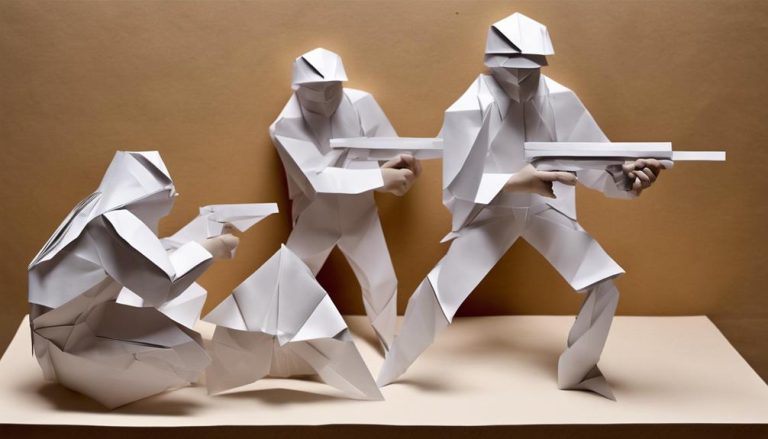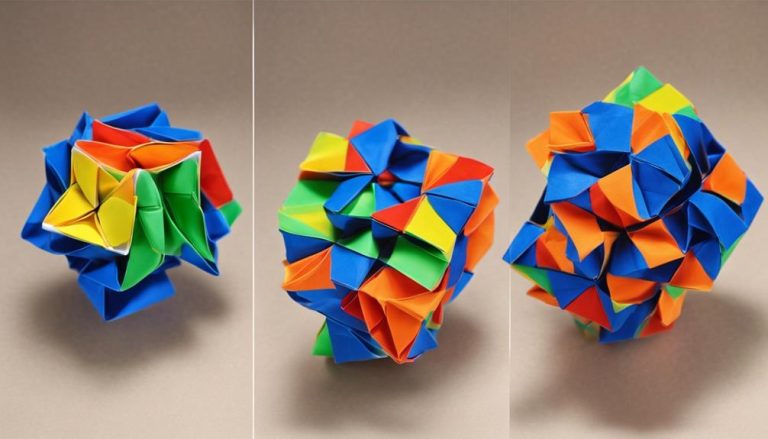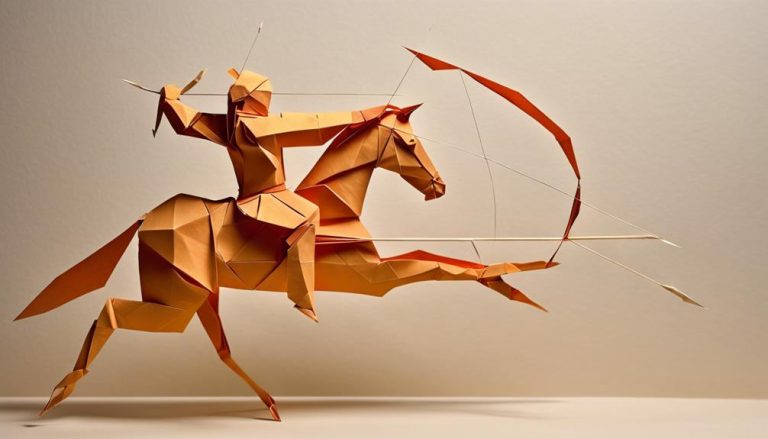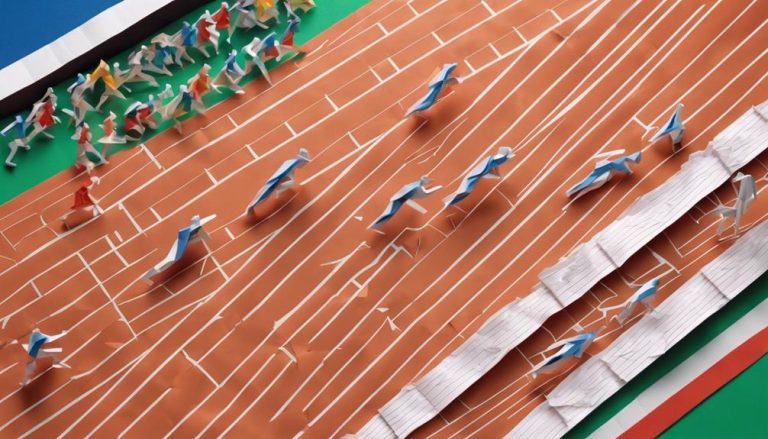General Rules of Hurling Sport
If you're curious about hurling, here are some general rules to get you started: Scoring involves putting the sliotar between the goalposts for points. Equipment needed includes a hurley and helmet for safety. Different player positions have specific roles. Fouls and penalties are indicated by referees. Matches consist of two 35-minute halves. Knowing when to substitute players can impact the game. Tactics like exploiting opponents' weaknesses are essential. Understanding these basics will give you a good grasp of the sport's essentials. Further insights await on the intricacies and strategic depths of hurling.
Scoring in Hurling
In hurling, scoring is achieved by propelling the sliotar between the goalposts using a hurley. To score, players can either kick the sliotar over the bar for one point or drive it into the goal under the bar for three points. These scoring techniques require precision and skill, testing the accuracy of both forwards and midfielders. Defensive strategies play an important role in preventing the opposing team from scoring, involving close marking, intercepting passes, and blocking shots.
Goalkeepers have significant responsibilities in hurling, being the last line of defense. They must have quick reflexes, good decision-making skills, and excellent communication with their defenders. Goalkeepers often initiate attacking plays by sending the sliotar back into play strategically. Forward tactics are focused on creating goal-scoring opportunities by outmaneuvering the opposition's defense, making runs, and positioning themselves effectively to receive passes and take shots on goal. Understanding these scoring dynamics and strategies is essential for a successful hurling team.
Equipment Requirements
To properly engage in hurling, players must make sure they have the necessary equipment. Here are three essential items you need to play hurling safely and effectively:
- Hurling Stick: Known as a 'hurley,' this stick is used to hit the sliotar (ball) during the game. It is essential to choose a hurley that is the right size and weight for you to maximize your performance and minimize the risk of injury. Safety precautions such as wearing protective gloves while handling the hurley can also prevent accidents.
- Helmet: Safety is paramount in hurling, so wearing a helmet is pivotal to protect yourself from head injuries during the game. When selecting a helmet, make sure it fits properly and meets the necessary safety standards to shield you from potential impacts.
- Protective Gear: In addition to a helmet, players should consider wearing other protective gear such as shin guards, mouthguards, and padding to minimize the risk of injuries. Prioritizing safety precautions not only safeguards you during the game but also allows you to focus on skill development and team bonding.
Player Positions and Roles
Player positions in hurling sport are vital for strategizing gameplay and maximizing team performance. Understanding defensive tactics and effective communication strategies are key components for success on the field. Team formations play an essential role in determining the positioning of players and their roles during gameplay. Let's explore the various player positions and their responsibilities:
| Position | Role |
|---|---|
| Goalkeeper | Protects the goal, initiates attacks |
| Full-backs | Mark key opposition players |
| Half-backs | Support defense, start attacks |
| Midfielders | Link defense and attack |
| Half-forwards | Support midfield, score goals |
| Full-forwards | Score goals, create opportunities |
Goalkeeper responsibilities include guarding the goal, organizing the defense, and distributing the sliotar effectively. The coordination between players is crucial for a successful team, emphasizing the importance of communication strategies to guarantee seamless gameplay. Each player's position contributes uniquely to the team's overall performance, highlighting the significance of understanding and executing their roles effectively.
Fouls and Penalties
Moving from the discussion of player positions and roles, understanding the rules surrounding fouls and penalties in hurling sport is imperative for maintaining fair play and upholding the integrity of the game. Here are three key points to keep in mind:
- Referee Signals: Referees play an essential role in enforcing the rules of hurling. They use specific signals to indicate fouls or penalties committed by players. Understanding these signals is essential for players to know when they have infringed upon the rules.
- Player Discipline: Fair play and sportsmanship are foundational to hurling. Players are expected to adhere to the rules and regulations of the game, showing respect for their opponents and the officials. Discipline is key to ensuring a competitive yet respectful environment on the field.
- Penalties: When a player commits a foul in hurling, penalties may be awarded to the opposing team. These penalties can vary in severity depending on the nature of the offense. It is crucial for players to understand the consequences of their actions to avoid putting their team at a disadvantage.
Game Duration and Structure
When it comes to the points system in hurling, each score has its importance. A goal, worth three points, can quickly change the course of a game. Meanwhile, a point, scored by sending the ball over the crossbar, is a crucial way for teams to accumulate points throughout the match.
Time and Breaks
During a game of hurling, understanding the time and breaks structure is essential for players and spectators alike. Here are three key points to keep in mind:
- Time management: Hurling matches consist of two halves, typically lasting 35 minutes each. Efficient time management is important for teams to strategize and adapt during gameplay.
- Halftime strategy: The break between halves offers an opportunity for teams to regroup, adjust tactics, and address player fatigue. Coaches play a crucial role in guiding their teams during this critical period.
- Break tactics, player fatigue: Utilizing breaks smartly can help alleviate player fatigue and prevent injuries. Teams must plan their substitutions and hydration strategies to maintain peak performance throughout the game.
Field Layout
Ever wondered about the intricate layout of a hurling field and how it impacts the duration and structure of the game? Hurling fields are rectangular in shape, typically around 137-145 meters long and 82-88 meters wide. The field is divided into two halves by a halfway line, with goalposts at each end. Player positioning is vital in hurling, with 15 players on each team. Positions are varied, with defenders, midfielders, and forwards strategically placed to optimize gameplay. The duration of a hurling match is usually 70 minutes, divided into two halves of 35 minutes each. Understanding the field dimensions and player positioning is essential for players to effectively navigate the field and execute their game plan successfully.
Umpires and Referees
Umpires and referees play an important role in maintaining fairness and enforcing the rules in the sport of hurling. Here are three key aspects to ponder regarding their roles and responsibilities:
- Roles and Responsibilities: Umpires are accountable for making decisions on the field, such as awarding scores, fouls, and issuing penalties. Referees oversee the game, ensuring that it is played according to the rules and maintaining order among players.
- Communication and Signals: Clear communication is essential in hurling. Umpires and referees use specific signals to indicate different infractions or decisions, allowing players, coaches, and spectators to comprehend what is happening on the field.
- Fairness and Impartiality: Umpires and referees must uphold fairness and impartiality throughout the game. They need to make quick and accurate judgments while remaining neutral, ensuring that all players have an equal opportunity to showcase their skills within the boundaries of the rules.
Substitutions and Team Management
Replacements and team management are essential aspects of the game, impacting strategy and player performance considerably. Player substitutions are pivotal strategic decisions that can shift the momentum of a hurling match. Knowing when to substitute a player can rejuvenate a team's energy or provide fresh tactics to break through the opponent's defense. It requires a keen understanding of each player's strengths and weaknesses, as well as an awareness of the game's flow.
Team lineup is another critical element that falls under team management. Coaches must make tactical adjustments based on the strengths and weaknesses of both their own team and the opposition. This could involve altering positions, changing formations, or adapting the overall game plan to exploit the opponent's vulnerabilities. Effective team management ensures that the players are in their optimal positions to maximize their contribution to the team.
In hurling, the ability to make timely substitutions and astute team management decisions can be the difference between victory and defeat. It is a dynamic aspect of the sport that requires constant assessment and quick thinking to outmaneuver the opposing team.
Tournament Formats and Championships
When approaching the topic of Tournament Formats and Championships in hurling, you will explore various elements such as Tournament Structures, Championship Criteria, and Winning Strategies. Understanding the structure of tournaments, the criteria for championships, and the strategies that lead to victory is essential for any hurling enthusiast looking to compete at a high level. These points will serve as the backbone for your grasp of how tournaments are organized and championships are won in the thrilling sport of hurling.
Tournament Structures
In the world of hurling sport, Tournament Structures play an important role in determining the format and organization of championships. When it comes to organizing hurling tournaments, there are several key structures that are commonly used to guarantee fair play and exciting competition:
- Knockout Stages and Seeding: Knockout stages involve teams being eliminated as they lose matches, culminating in the crowning of a champion. Seeding ensures that top-performing teams face lower-ranked opponents early on, adding an element of strategy to the tournament.
- Round Robin and Group Stage: In a round-robin format, teams play against every other team in their group, with the top teams advancing to the next stage. Group stages involve dividing teams into groups, with the top teams from each group moving forward in the competition.
Championship Criteria
Championship criteria in hurling sport encompass a variety of tournament formats and championships that showcase the competitive nature and skill of teams participating at different levels. Qualifying rounds often determine which teams advance to the main championship format, with seeding playing a vital role in setting up matchups. The championship format typically includes playoffs where teams compete in knockout rounds until a winner is crowned. These playoffs intensify as teams vie for the championship title, creating an electrifying atmosphere for players and fans alike. The structure of hurling championships guarantees that only the best teams progress, highlighting the importance of consistency and performance under pressure. Understanding the championship criteria is essential for teams aiming to navigate their way to victory in the thrilling world of hurling sport.
Winning Strategies
To excel in tournament formats and championships in hurling sport, strategic planning and adaptability are key components for teams seeking success. When aiming for victory, consider the following:
- Offensive Tactics: Developing a strong offensive strategy is essential to outmaneuvering opponents and scoring goals effectively.
- Defensive Strategies: Solid defensive tactics help in preventing the opposition from scoring, giving your team a better chance of winning.
- Teamwork Dynamics and Individual Skills: Balancing teamwork dynamics with individual player skills is vital for a well-rounded team performance that can adapt to different game situations.
Frequently Asked Questions
Can Players Wear Jewelry or Accessories During a Hurling Match?
During a hurling match, wearing jewelry or accessories can impact your performance and pose safety concerns. They may cause distractions and are often regulated for player safety. Consider avoiding them to focus on the game.
Are There Any Restrictions on the Type of Footwear That Can Be Worn During a Hurling Game?
When gearing up for a hurling game, the sky's the limit with cleat options. However, guarantee safety comes first. Avoid slipping and sliding—pick a reliable pair. Whether flashy or simple, choose wisely!
Is There a Limit to the Number of Players a Team Can Have on the Field at One Time?
Yes, there is a limit to the number of players a team can have on the field at one time in hurling. Player substitutions are common, with strict time limits. Field size and team strategy play essential roles in this fast-paced sport.
How Are Tiebreaker Situations Handled in Hurling Tournaments?
When a tie grips the tournament, the intensity rises. Overtime rules bring sudden death drama. Penalty shootouts or extra time can break the deadlock, stirring emotions as players fight for victory in hurling tournaments.
Are There Any Specific Rules Regarding the Size and Weight of the Hurley Stick Used in Hurling Matches?
When it comes to selecting your hurley stick, make sure it adheres to regulations for player safety. Stick design and customization are permitted within specified size and weight limits to maintain fairness and prevent injury.






